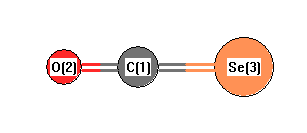Vibrational Frequencies calculated at B2PLYP=FULL/aug-cc-pVTZ
| Mode Number |
Symmetry |
Frequency
(cm-1) |
Scaled Frequency
(cm-1) |
IR Intensities
(km mol-1) |
Raman Act
(Å4/u) |
Dep P |
Dep U |
|---|
| 1 |
Σ |
2042 |
1959 |
707.06 |
40.47 |
0.74 |
0.85 |
| 2 |
Σ |
665 |
638 |
5.49 |
26.05 |
0.08 |
0.15 |
| 3 |
Π |
475 |
455 |
0.26 |
0.37 |
0.75 |
0.86 |
| 3 |
Π |
475 |
455 |
0.26 |
0.37 |
0.75 |
0.86 |
Unscaled Zero Point Vibrational Energy (zpe) 1827.9 cm
-1
Scaled (by 0.9594) Zero Point Vibrational Energy (zpe) 1753.7 cm
-1
See section
III.C.1 List or set vibrational scaling factors
to change the scale factors used here.
See section
III.C.2
Calculate a vibrational scaling factor for a given set of molecules
to determine the least squares best scaling factor.
